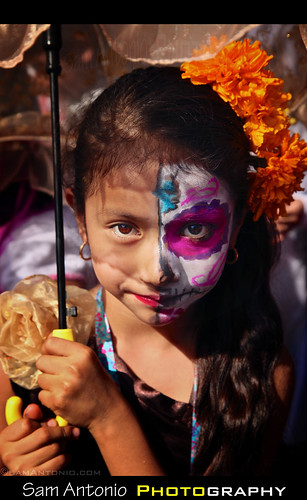
Making Photographs at the Day of the Dead - Oaxaca City, Mexico, a photo by Sam Antonio Photography on Flickr.
==================================================================
There it was shattered on the ground in three pieces. Three pieces was all that was left...countless memories captured for a lifetime laying on the ground.
I stared at my broken Olympus Stylus compact film camera with stunned disbelief. Just a moment before I handed it to my brother, Rick, to take a photo of me and he jokingly fumbled with it to pretend it was going to slip out of his hand...unfortunately it did.
So there we were at the Rock of Gibraltar on the Iberian Peninsula with a broken camera and one angry brother.
Unbeknownst to me this would be my beginning into digital photography. The year was 2000 and in 2001 I would buy my first digital camera, a Canon PowerShot S100. I would never load another roll of film in a camera again.
In subsequent years I would buy bigger and more expensive Canon digital SLR cameras to parallel my growing understanding in photography. As with most budding photographers I started out taking snapshots, then progressing to “postcard” images and now I find myself involved in expressive travel photography. Photography with meaning and emotion.
When I first started to get serious with digital photography my primary focus was landscapes and cityscapes. One day I was in a cafe with a friend showing my photos from a recent trip. After I was done he said, “Great photos of buildings and landscapes, but what of the local people? Where is the soul of the country?” That comment has stuck with me ever since.
In 2008 I started to change my focus from beautiful sunsets, cityscapes at dusk, and national parks to people photography, in particular, street photography.
Henri Cartier-Bresson said, "You don't take a photograph, the photograph takes you."
That is the essence of street photography. You never know what is around that next corner, who will step in the frame or how your subject will react.
Photographing people in my travels has always been difficult. I have no problem delivering a speech before hundreds of people, but approaching strangers and asking for a photograph was a whole different story.
The great photojournalist Robert Capa once stated, “If your pictures aren’t good enough, you’re probably not close enough.” To understand the people you are photographing you must be in proximity to them. It’s not the camera equipment that makes a successful photograph, but rather the connection you make with people that makes all the difference.
On my recent trip to Mexico last year I wanted to take “good pictures” by getting “close” to the Mexican people.
Ansel Adams once said, “You don’t take a photograph, you make it.”
In the beautiful colonial city of Oaxaca, Mexico the vibrant celebration of Day of the Dead celebration was pouring out on the streets. I saw this photogenic young girl and wanted to make her photograph. Ten minutes earlier there were clouds in the sky making for even, diffused light, suddenly some of those clouds dissipated which made for uneven light. I spotted one of the parents holding an umbrella as part of their costume and I asked them if I could borrow it for a moment. I handed it to this young girl to shade her face and to cut down on the bright light.
I didn’t take this photograph, I made it.
Happy Travels!
Text and photo copyright by ©Sam Antonio Photography
Facebook | Google + | Twitter | Pinterest | Photography Blog | Travel Photography Gallery

No comments:
Post a Comment